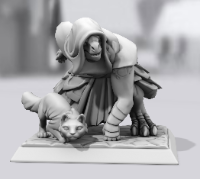David M. said: Thanks Keith. So if I wanted to add additional emojis, do I need to convert the Codepoint values to hex or something and add to the enumerated list? Using an online Unicode to Hex converter I'm getting something like U+FE0F (Red Heart) = 0x55 0x2b 0x46 0x45 0x30 0x46, which doesn't match the format of what I'm seeing for the existing list. Also, I see now that manual deletion is just selecting the text and bubble and pressing delete, derp. I can add something to delete emojis from the control panel; rotating the token works too, or any other change to the token. It replaces one with another if you emoji something else so no worry about overlap. The references for different emoji I use are at emojipedia, and I use the unicode notation - those are usually given as "U+EF0F" for example (this is the variant selector-16) <more on this later. Translating those for what I've got in the tiny library (tried to keep it to 60 options to avoid overwhelming the user) is taking off the "U+" and replacing it with "0x" (zero-lowercase x) - and in the library I've got I give it a unique text key that doesn't have to relate to the actual emoji at all. For most entries it's like so: "demon":0x1F479, "dragon":0x1F432, "scroll":0x1F4DC, ...where each entry has a single number. Some (referencing the variant selector above) use an emoji variant of what already was a zapfdingbat, symbol, or other annotation: "alchemy":[0x2697, 0xFE0F], ...so I store those as arrays, use a function to translate each element as an entity, then cram them together for output to create the emoji version. The alembic was already in most available fonts, so the variant selector tells it to instead use the "emoji" (full color, etc.) version instead of the font-specific font-colored version. The most complex one of these is the eye-speech-bubble which uses a "connector" entity as well (0x200D): "interrogate":[0x1F441,0xFE0F,0x200D,0x1F5E8,0xFE0F], Edited to add: For your reference: <a href="https://emojipedia.org/emoji/%F0%9F%92%A9/" rel="nofollow">https://emojipedia.org/emoji/%F0%9F%92%A9/</a> 1F4A9








